In practice, the open TETRA standard is a suite of standards covering different technology aspects, e.g. air interfaces, network interfaces and their services and facilities.
TETRA mobile stations (MS) commonly communicate using the radio trunking infrastructure (switching & management infrastructure, SwMI) made of TETRA base stations (TBS). Alternatively, direct communications between mobile terminals are possible in situations where network coverage is not available, e.g. in emergency situations.
The common mode of operation is a group calling mode, immediately connecting the user to selected call groups and/or a dispatcher. Additionally, half- and full-duplex direct connections can be established to other TETRA mobile users or clients in the public and private telephone networks (PSTN and PBX), much like using mobile phones (cell phones).
Access to network resources is automatically managed using multiple priority levels providing different grade of service levels (or tariff structures) to the user, but it also considers emergency calls or pre-emptive priority calls. Several data transmission possibilities as well as the dynamic creation of unique temporary call groups further round out the TETRA service portfolio and are used to handle various communications needs.
TETRA-based products can facilitate built-in encryption features to ensure the privacy and confidentiality of sensitive data and voice communications. Different levels of security are provided by standardized security mechanisms such as authentication, air interface encryption (AIE) and end-to-end encryption (E2EE).
With TETRA Release 2, high-speed data (HSD) enhancements are incorporated, commonly referred to as TETRA enhanced data service (TEDS). Basically, the TEDS specification enhances the throughput capabilities of the TETRA packet data service. Overall, TETRA 2 specifications introduce additional new modulation schemes, channel coding, various coding rates as well as three new channel bandwidths (50 kHz, 100 kHz and 150 kHz) to the standard. TETRA 2 is fully compatible with TETRA Release 1 for ease of migration.




